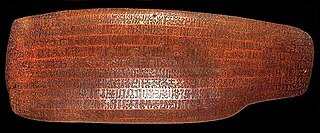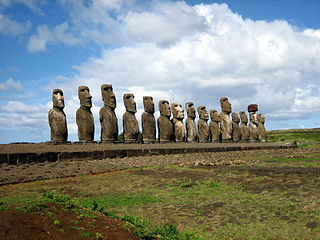The supi is a war club of the Solomon Islands.

The supi is a war club of the Solomon Islands.

Cut from iron wood, its diamond shaped head is specific to the Solomon Islands. [1] About thirty centimetres long, it has a carved striking head with well-marked ribs. It is native to Malaita island. [2] Besides its common name of supi, it can sometimes be referred to as a supe or subi. [3] Some were carved from whale bones. [4] The handle was sheathed with coconut fibre braiding, sometimes engraved or inlaid with shells. Some, carved with a crocodile face at their end, were reserved for the tribes chiefs. [5]


The Marquesas Islands are a group of volcanic islands in French Polynesia, an overseas collectivity of France in the southern Pacific Ocean. Their highest point is the peak of Mount Oave on Ua Pou island, at 1,230 m (4,035 ft) above sea level.

Rongorongo is a system of glyphs discovered in the 19th century on Easter Island. It is not yet known whether rongorongo represents true writing or proto-writing. Numerous attempts at decipherment have been made, but none have been successful so far. Although some calendrical and what might prove to be genealogical information has been identified, none of these glyphs can actually be read. If the system is writing and proves to be an independent invention, it would be one of very few independent inventions of writing in human history.

Bael is a demon described in demonological grimoires such as The Lesser Key of Solomon and the Pseudomonarchia Daemonum and also in the Dictionnaire Infernal. He is described as a hoarsely-voiced king with the power to make men invisible and ruling over sixty-six legions of demons. The Lesser Key of Solomon describes him as appearing in the form of a cat, toad, human, some combination thereof, or other "diverse shapes", while the Pseudomonarchia Daemonum and the Dictionnaire Infernal state that he appears with the heads of a cat, toad, and human simultaneously.
The Lesser Key of Solomon, also known as Lemegeton Clavicula Salomonis or simply Lemegeton, is an anonymously authored grimoire on sorcery. It was compiled in the mid-17th century, mostly from materials several centuries older. It is divided into five books: the Ars Goetia, Ars Theurgia-Goetia, Ars Paulina, Ars Almadel, and Ars Notoria. It is based on the Testament of Solomon and the ring mentioned within it that he used to seal demons.

Solomon Islands, also known simply as the Solomons, is a country consisting of six major islands and over 900 smaller islands in Melanesia, part of Oceania, to the northeast of Australia. It is directly adjacent to Papua New Guinea to the northwest, Australia to the southwest, New Caledonia and Vanuatu to the southeast, Fiji, Wallis and Futuna, and Tuvalu to the east, and Nauru and the Federated States of Micronesia to the north. It has a total area of 28,896 square kilometres, and a population of 734,887 according to the official estimates for mid 2023. Its capital, Honiara, is located on the largest island, Guadalcanal. The country takes its name from the wider area of the Solomon Islands archipelago, which is a collection of Melanesian islands that also includes the Autonomous Region of Bougainville, but excludes the Santa Cruz Islands.

A wand is a thin, light-weight rod that is held with one hand, and is traditionally made of wood, but may also be made of other materials, such as metal, plastic or stone. Long versions of wands are often styled in forms of staves or sceptres, which could have large ornamentation on the top.

In architecture, a corbel is a structural piece of stone, wood or metal jutting from a wall to carry a superincumbent weight, a type of bracket. A corbel is a solid piece of material in the wall, whereas a console is a piece applied to the structure. A piece of timber projecting in the same way was called a "tassel" or a "bragger" in England.

Moai or moʻai are monolithic human figures carved by the Rapa Nui people on Rapa Nui in eastern Polynesia between the years 1250 and 1500. Nearly half are still at Rano Raraku, the main moai quarry, but hundreds were transported from there and set on stone platforms called ahu around the island's perimeter. Almost all moai have overly large heads, which account for three-eighths of the size of the whole statue. They also have no legs. The moai are chiefly the living faces of deified ancestors.

A club is a short staff or stick, usually made of wood, wielded as a weapon since prehistory. There are several examples of blunt-force trauma caused by clubs in the past, including at the site of Nataruk in Turkana, Kenya, described as the scene of a prehistoric conflict between bands of hunter-gatherers 10,000 years ago.

Waite Phillips was an American petroleum businessman who created a fully integrated operation that combined petroleum producing, refining and marketing. With headquarters in Tulsa, Oklahoma, he also developed several office complexes and engaged in banking and ranching. Phillips was a philanthropist for both local Tulsa institutions and national causes. In Tulsa he built a 72-room mansion for his residence, which he later donated to the city; it became the Philbrook Museum of Art. He gave 127,000 acres (510 km2) of his favorite ranch in New Mexico to the Boy Scouts of America, together with an office building as part of its endowment. The ranch is now Philmont Scout Ranch, one of the largest youth camps in the world. Phillips also made a substantial bequest to the University of Southern California, which named a building after him.

West Point was a point of land on Hong Kong Island, Hong Kong, south of Sulphur Channel. Its location is the shore off Pok Fu Lam Road and Queen's Road West in 1845, approximately the junction of Western Street and Des Voeux Road West near Western Police Station. This was the northernmost point on the western half of Hong Kong Island.

The Philtower Building is a historic building located at 427 South Boston Avenue in Tulsa, Oklahoma.

The ancient Cycladic culture flourished in the islands of the Aegean Sea from c. 3300 to 1100 BCE. Along with the Minoan civilization and Mycenaean Greece, the Cycladic people are counted among the three major Aegean cultures. Cycladic art therefore comprises one of the three main branches of Aegean art.

Solomon's knot is a traditional decorative motif used since ancient times, and found in many cultures. Despite the name, it is classified as a link, and is not a true knot according to the definitions of mathematical knot theory.

Solomon Islands dance is part of the culture of the Solomon Islands. Dances are performed at ceremonies and special occasions, as well as on a regular basis in some hotels and restaurants, which feature local musicians performing traditional songs and dance. The National Museum of Solomon Islands at Point Cruz also organises live dances and other cultural displays of its provinces.

The University of Queensland Anthropology Museum is located in Brisbane, Australia. It houses the largest university collection of ethnographic material culture in Australia.

Oceanian culture encompasses the collective and diverse customs and traditions of art, architecture, music, literature, lifestyle, philosophy, politics and religion that have been practiced and maintained by the many ethnic groups of the geographical region of Oceania since prehistory. Cultures of Oceania reflect not only that of the region's indigenous peoples, but also the cultures brought by European colonisation and the United States, particularly through mass culture such as cinema and TV. Oceania is commonly divided into four geographic sub-regions, characterized by shared cultural, religious, linguistic, and ethnic traits: Australasia, Melanesia, Micronesia, and Polynesia. Most Oceanian countries are multi-party representative parliamentary democracies, and tourism is a large source of income for the Pacific Islands nations.

Tomako or tomoko is a large war canoe from the Solomon Islands. The name "tomako" is used in New Georgia in the Roviana language. It is also known as magoru in Marovo, niabara in Vella Lavella, mon in Bougainville, ora in Makira, and iola or ola in Malaita and Ulawa. Tomako were narrow and usually between 12 and 18 m in length. They did not possess outriggers or sails and were propelled solely by paddling. They were built by fitting planks edge-to-edge which are then "sewn" together and caulked with a paste made from the nut of the tree Parinarium laurinum. They could carry 30 to 50 warriors, and were used in raiding expeditions for slaves or for headhunting. They were characteristically crescent-shaped, with sharply upturned prows and sterns that were decorated with fringes of cowrie shells, nautilus shells, and mother-of-pearl, as well as intricate carvings. These carvings are usually of spirit animals or warriors like the kesoko and Tiolo. The body is commonly blackened to contrast with the decorations.
A roromaraugi is a parrying shield from San Cristobal Island in the Solomon Islands.

A qauata or qauaata is a parrying shield or war club of the San Cristobal Island in the Solomon Islands.